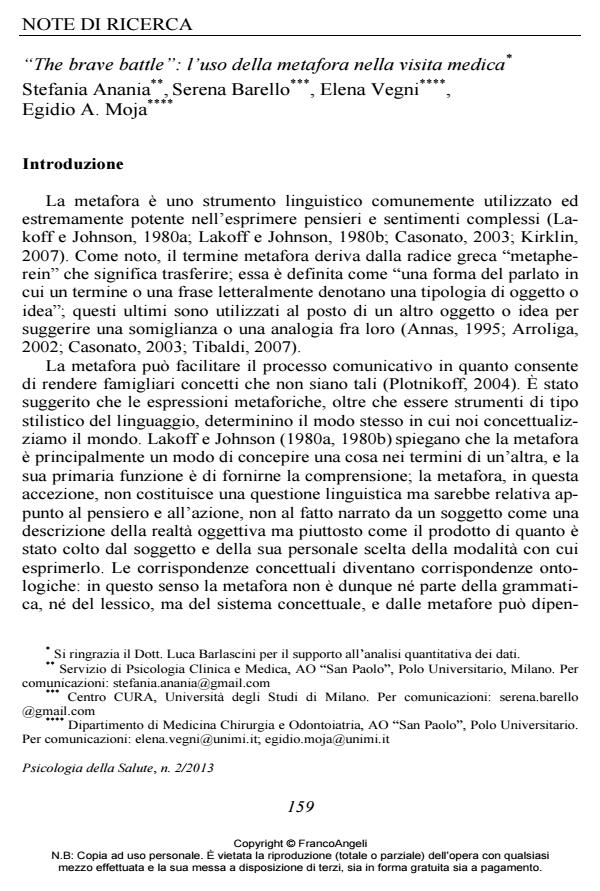"The brave battle": l’uso della metafora nella visita medica
Titolo Rivista PSICOLOGIA DELLA SALUTE
Autori/Curatori Stefania Anania, Serena Barello, Elena Vegni, Egidio A. Moja
Anno di pubblicazione 2013 Fascicolo 2013/2
Lingua Italiano Numero pagine 14 P. 159-172 Dimensione file 449 KB
DOI 10.3280/PDS2013-002010
Il DOI è il codice a barre della proprietà intellettuale: per saperne di più
clicca qui
Qui sotto puoi vedere in anteprima la prima pagina di questo articolo.
Se questo articolo ti interessa, lo puoi acquistare (e scaricare in formato pdf) seguendo le facili indicazioni per acquistare il download credit. Acquista Download Credits per scaricare questo Articolo in formato PDF

FrancoAngeli è membro della Publishers International Linking Association, Inc (PILA)associazione indipendente e non profit per facilitare (attraverso i servizi tecnologici implementati da CrossRef.org) l’accesso degli studiosi ai contenuti digitali nelle pubblicazioni professionali e scientifiche
In letteratura mancano studi sistematici che descrivano l’utilizzo della metafora nella visita medica. Questo studio ha l’obiettivo di descrivere l’uso della metafora in visite di medicina generale raccogliendo: la frequenza dell’uso delle metafore; il soggetto conversazionale che attiva la metafora; la distribuzione delle metafore sulla base del tempo di comparsa; il contenuto semantico o significato della metafora (di cosa parla) e il contenitore semantico o significante della metafora (come ne parla); le funzioni connesse all’uso della metafora (funzione cognitiva vs funzione emotiva). Lo studio ha considerato 100 visite di medicina generale videoregistrate. Di queste sono state selezionate e trascritte quelle parti in cui comparivano metafore intese come un modo di concepire una cosa nei termini di un’altra. L’analisi dei dati ha previsto un’analisi quantitativa delle frequenze per i parametri: soggetto produttore e tempo, e una qualitativa tramite una categorizzazione del contenuto delle metafore e, a seguire, una tassonomia categoriale delle metafore stesse. Sono state osservate 280 metafore: il 43.2% del medico, e il 56.8% del paziente. In 41 visite il soggetto attivatore è il paziente (55.4%). Su 100 visite studiate, in media, viene utilizzata una metafora ogni 3’30’’. Le categorie rilevate si sovrappongono parzialmente con gli esiti di altri studi. I pazienti usano un numero maggiore di metafore rispetto ai medici, concentrandole nella prima parte della visita con funzione di mediatore emotivo. Nel loro insieme i risultati evidenziano come la metafora sia uno strumento linguistico specifico della comunicazione e relazione medico-paziente. .
Parole chiave:Metafora, visita ambulatoriale, medicina generale, comunicazione medicopaziente
- Interpersonal Argumentation in Educational and Professional Contexts Francesca Alby, Marilena Fatigante, Cristina Zucchermaglio, pp.183 (ISBN:978-3-319-59083-7)
Stefania Anania, Serena Barello, Elena Vegni, Egidio A. Moja, "The brave battle": l’uso della metafora nella visita medica in "PSICOLOGIA DELLA SALUTE" 2/2013, pp 159-172, DOI: 10.3280/PDS2013-002010